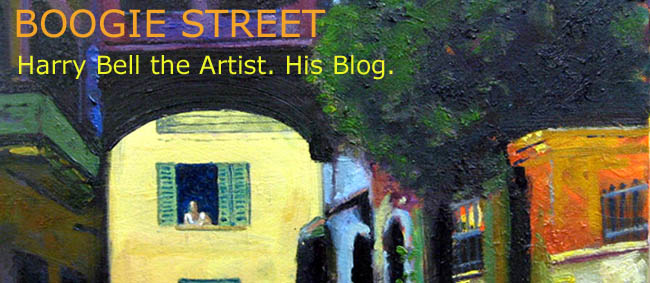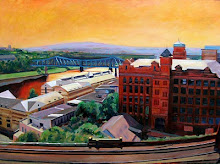Starting with Diebenkorn, I’ve gradually been exploring a small selection of Bay Area painters. After Diebenkorn came Wayne Thiebaud, then Elmer Bischoff. I was able to pick up books on all three without too much effort, but publications on Staprans eluded me. Until now. Last week I took delivery from Amazon of Raimonds Staprans: Art of Tranquility and Turbulence by Paul Karlstrom.
Karlstrom is clearly something of an expert on Staprans. In the Smithsonian Archive of American Art is an interview Staprans gave to Karlstrom in 1997. It’s a fascinating insight into Staprans’s thoughts about art, the development of his career and how he feels it was held up by staying with one gallery. In particular, his comments about the work of Diebenkorn and Thiebaud are illuminating, even if, at times I think he may be wrong in his conclusions.
I read this interview a couple of years ago, but reading the interview without the benefit of some printed images as illustrations occasionally made for opaque understanding. So it was rewarding in a number of ways to find that a book had finally been published about Staprans and his work.
The pictures in it form something of a retrospective, not surprisingly because it was conceived in connection with a retrospective exhibition of Staprans’s work at the Pasadena Museum of California Art in January 2006 (which then transferred to the Latvian National Museum in Riga).
The paintings begin in the early 196os in a very West Coast abstract way, with hints of de Stael in the blocks of thick colour, but these are gradually replaced by abstract landscapes composed of large areas of broad smooth colour.
In the early 70s, Staprans turned to the female figure for subject matter and there are a number of quite disturbing female nudes, their heads almost non-existent, their genitalia aggressively displayed and the pictures suffused overall with blood red. Staprans has some firmly held views on sexuality which he talks about in the Smithsonian interview and which are the main theme of one of his most famous Latvian plays, The Freezing (excerpted in the book).
Of greatest interest to me are the later landscapes, and some of the still lifes of cans of paint, tables and fruit. The landscapes are quite striking. On first viewing they appear to be severe landscapes with all human life and any incidental detail removed. There’s an eerie silence to them and they’re all bathed in the fierce glare of Californian sunlight.. Staprans says:
As one deplanes in San Francisco, one is blinded by the unbelievable intensity of the sun. And the light is so white and so aggressively energizing, that one automatically gropes for his sunglasses. And so it goes for eight months each year – nothing but blue skies and that blinding light. It is impossible to ignore it.
Yet Staprans maintains that all of them – still lifes and landscapes - are constructs, not taken directly from the real world or real locations at all. He’s working in the field of what he calls abstract realism. He builds his pictures “from the ground up,” making compositional sketches and working with a strict geometry, he attempts to create order out of what he sees as the chaos of the natural world.












3 comments:
Thanks for this, Zip. I had not heard of Staprans.
I wonder how well he's known outside of America, or even California.
I`m a UK based painter-almost 50.Though not much of an authority I hadn`t heard of Staprons. But for me one of the many great joys with the world of painters is finding new ones to inspire and excite...I "found" him only the other day on the internet via Artworks a USA magazine-safe to say made my week.. Thanks Eugene
www.imagefromthevillage.co.uk
Post a Comment